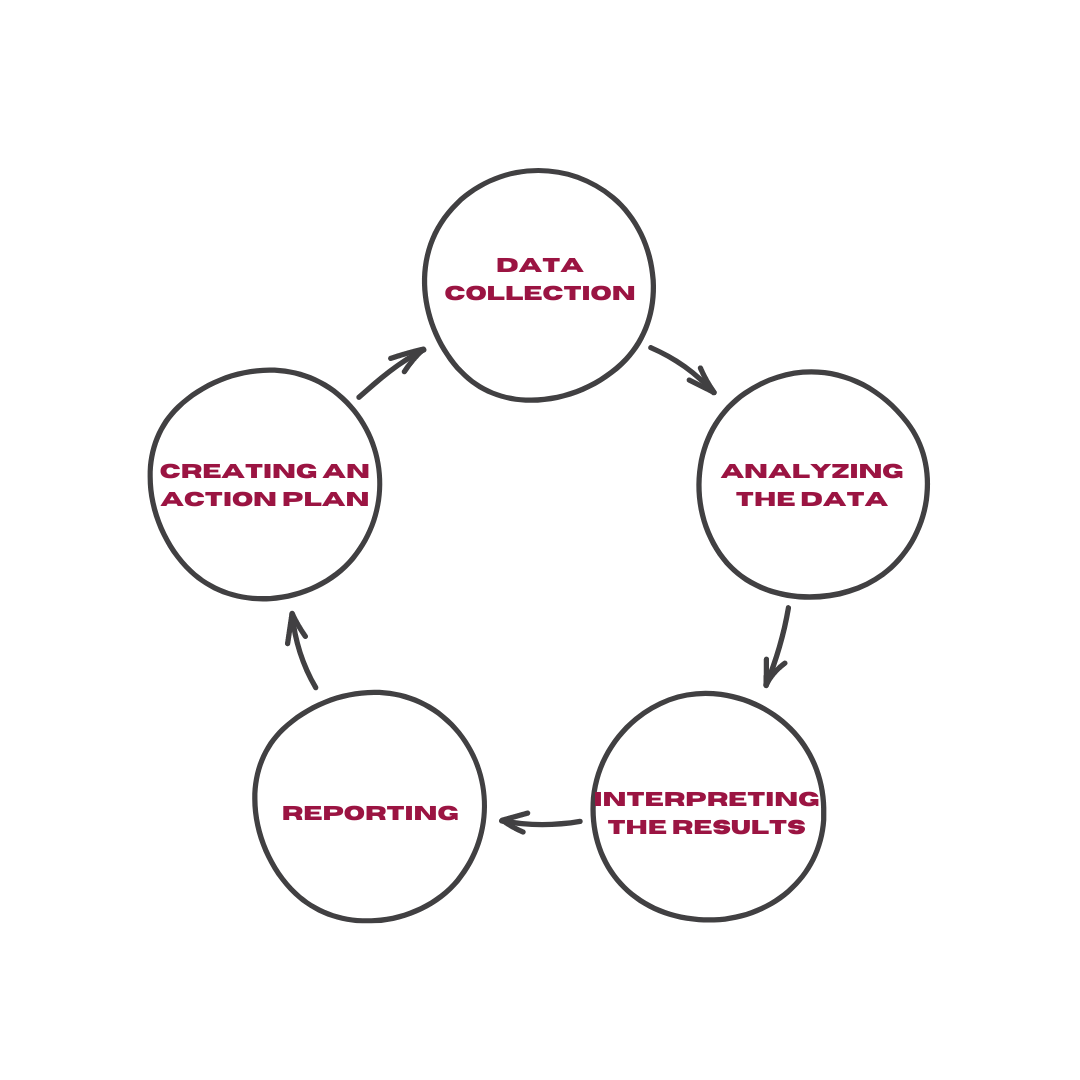KPI is an abbreviation for "Key Performance Indicator." It denotes specific metrics used to measure and evaluate the performance of an organization or an individual in achieving their goals. KPIs are used to assess success, track performance, and understand progress towards achieving strategic objectives.
How Are KPIs Determined?
Key Performance Indicators (KPIs) are specific measurements used to gauge the performance of an organization or an individual. KPIs are determined with the aim of reaching objectives, assessing success, and monitoring progress towards strategic goals. The first step is understanding the defined objectives
Key performance indicators and goal setting are guided by five fundamental principles encoded as "SMART":
Specific

What exactly do you want to achieve?
Measurable
How will you determine that you have reached your goal?
Achievable
Is your goal truly attainable?
Relevant (and Realistic)
Is it relevant to you, or, in other words, does it align with where you want to be?
Time-bound
When will you reach your goal, and what are the important milestones?
Later, it is important to identify measurements that are critical to reaching these goals. The measurements should provide objective and meaningful data for monitoring performance. When selecting KPIs, the focus should be on key areas such as strategic objectives, customer satisfaction, financial success, and process effectiveness. Once we identify KPIs, we should regularly monitor and revise them as needed, enabling the organization or individual to continually improve and achieve goals more effectively.
How is KPI Calculated?
Data Collection: Gathering the necessary data is required to calculate the KPI. This data may typically pertain to business processes, customer satisfaction, financial status, or other specified performance areas.
.png?access_token=6cebd9e0-bfcc-4ea8-87fb-5c32f1b959cc)
Analyzing the Data: The collected data is analyzed to assess the target performance indicator. This usually involves mathematical calculations, ratios, percentages, or other measurements.
Interpreting the Results: Analysis results are interpreted, providing an assessment of whether the goal has been achieved or not. The obtained results are used to understand the strengths of performance and areas that need improvement.
Reporting: KPI results should be regularly reported to relevant stakeholders. These reports help stakeholders better understand the organization's or individual's performance and manage the process of achieving strategic goals.
Creating an Action Plan: The analysis of KPIs determines whether action is needed to improve performance or achieve goals. If necessary, an action plan is created and implemented
KPI calculation is a continuous process, and the identified KPIs can be revised or updated over time. This allows the organization or individual to adapt to changing conditions and manage their performance more effectively.
What Are the Types of KPIs?
KPIs are typically determined based on the organization's goals and strategic focus areas. Depending on the relevant industry and the organization's priorities, different types of KPIs can be used.
Financial KPIs:
Revenue Growth
Profit Margin
Cash Flow
Customer Profitability
Operational KPIs:
Production Efficiency
Raw Material Stock Levels
Delivery Times
Service Quality
Customer Satisfaction KPIs:
Customer Satisfaction Index (CSI)
Customer Complaint Rate
Repeat Sales Rate
Net Promoter Score (NPS)
Marketing KPIs:
Customer Acquisition Cost (CAC)
Conversion Rates
Brand Awareness
Social Media Engagement
Human Resources KPIs:
Employee Turnover Rate
Training Participation
Performance Evaluation Results
Job Satisfaction
Project Management KPIs:
Project Completion Time
Number of Projects within Budget
Resource Utilization Efficiency
Success Rate of Risk Assessment
Technology and Innovation KPIs:
Percentage of Innovative Products
Research and Development (R&D) Expenses
Innovation Speed
Reliability of Technology Infrastructure
Social Responsibility KPIs:
Environmental Impact
Social Contributions
Employee Volunteering
Ethical Practices
Why Are KPIs Important?
.png?access_token=49357083-60be-422b-8d74-e17012fce01e)
Key Performance Indicators (KPIs) function as a critical management tool for organizations and individuals. These indicators guide performance monitoring, evaluation, and focus on strategic goals by offering various advantages. KPIs enable organizations to continuously track their progress towards defined objectives. This process provides opportunities to identify strengths and weaknesses in performance, as well as areas for success and improvement.
KPIs support data-driven decision-making, providing managers and decision-makers with a stronger analytical foundation. They effectively guide the identification of improvement points in business processes, optimization of resources, and early detection of risks. This helps organizations gain strategic flexibility and sustain their competitive advantages.
Customer-focused KPIs play a significant role in increasing customer satisfaction. KPIs such as customer complaint rates, conversion rates, and Net Promoter Score (NPS) enable organizations to focus on improving product and service quality by measuring customer experience.
KPIs are used in evaluating performance and establishing reward systems. By supporting performance rewards, they enhance employee motivation and facilitate more effective communication within the organization.
KPIs contribute to organizations achieving sustainable success. These indicators establish a framework for monitoring, evaluating, and improving performance by providing guidance towards strategic goals.
Examples of KPIs
KPIs vary depending on different business areas and objectives. Commonly used KPIs in the business world can be categorized under key topics such as sales KPIs, production efficiency, and financial profitability.
Sales Revenue
Definition: Total revenue generated from sales.
Example KPI: Monthly or annual increase percentage of sales revenue.
Customer Satisfaction
Definition: Level of satisfaction among customers regarding a product or service.
Example KPI: Net Promoter Score (NPS) obtained from customer surveys conducted every month.
Customer Acquisition Cost (CAC)
Definition: Total cost incurred to acquire a new customer.
Example KPI: Average advertising and marketing expenses per customer acquisition.
Employee Turnover Rate
Definition: The rate of employees leaving the company within a specific period.
Example KPI: Annual employee turnover rate, indicating stability and employee satisfaction in the company.
Production Efficiency
Definition: Quantity of products produced per unit within a specific period.
Example KPI: Increase percentage in daily or weekly production quantity.
Inventory Turnover Ratio
Definition: How many times the inventory turnover occurs within a specific period.
Example KPI: Calculation of monthly inventory turnover ratio.
Website Conversion Rate
Definition: The rate at which visitors perform the desired action on a website.
Example KPI: Rate of filling out a contact form or purchasing a product.
Project Completion Time
Definition: Difference between the planned and actual completion time of a specific project.
Example KPI: Delay time in project completion compared to the finish date.
Financial Profitability Ratios
Definition: Ratios indicating the financial health of the company (e.g., gross profit margin, net profit margin).
Example KPI: Increase in gross profit margin percentage.
Social Media Engagement
Definition: Number of likes, comments, and shares a company receives on social media platforms.
Example KPI: Increase percentage in social media engagements on a monthly basis.
OKR vs KPI! Understanding the Differences
.png?access_token=bb23cb2a-19a6-40c3-a25b-865b9fc86392)
OKR (Objectives and Key Results) and KPI (Key Performance Indicators) are both performance management frameworks used for goal setting and performance measurement in organizations.
OKR focuses on setting ambitious yet achievable objectives along with measurable key results to track progress. It's about driving improvement and alignment towards common goals.
KPI, on the other hand, is about monitoring ongoing performance against predetermined benchmarks. It provides specific metrics to measure success in areas like revenue growth, customer satisfaction, and operational efficiency.
While OKRs push for innovation and motivation, KPIs offer a clear way to track progress and success. Together, they create a balanced approach to performance management.
KPI Performance Management with CloudOffix HR Cloud
CloudOffix HR Cloud offers an effective solution to companies for KPI performance management. This platform provides comprehensive features that assist organizations in identifying, monitoring, and managing key performance indicators.
The KPI performance management features of CloudOffix HR Cloud include the following:
Customizable KPI Definition
Companies can define custom performance indicators tailored to their own strategic objectives. This allows for the creation of a personalized performance evaluation system based on business processes and priorities.
Real-Time Monitoring
CloudOffix HR Cloud enables real-time monitoring of performance indicators. This allows organizations to access instant data and make quick decisions.
Employee Performance Evaluations
KPIs are used to measure and evaluate employee performance. CloudOffix HR Cloud facilitates regular evaluations and makes it easy to understand employee performance.
Goal Setting and Tracking
Employees and managers can systematically track progress towards set goals. This enables the assessment of performance alignment with goals and allows for adjustments if necessary.
Performance Reporting and Analysis
The platform presents performance data in detailed reports. These reports guide organizations in understanding their performance and making strategic adjustments.
Interactive Feedback Mechanism
By offering an interactive feedback mechanism between managers and employees, it strengthens communication and focuses on performance improvement.
Integration Capabilities
CloudOffix HR Cloud can integrate with other business applications and systems. This helps organizations consolidate all data in one platform and gain a holistic view.
CloudOffix HR Cloud strengthens organizations' journey towards achieving their goals by providing a more efficient, measurable, and focused approach to KPI Performance Management.
